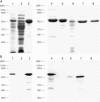A reassessment of substrate specificity and activation of phytochelatin synthases from model plants by physiologically relevant metals
- PMID: 16489135
- PMCID: PMC1435825
- DOI: 10.1104/pp.105.073635
A reassessment of substrate specificity and activation of phytochelatin synthases from model plants by physiologically relevant metals
Abstract
Phytochelatin synthases (PCS) catalyze phytochelatin (PC) synthesis from glutathione (GSH) in the presence of certain metals. The resulting PC-metal complexes are transported into the vacuole, avoiding toxic effects on metabolism. Legumes have the unique capacity to partially or completely replace GSH by homoglutathione (hGSH) and PCs by homophytochelatins (hPCs). However, the synthesis of hPCs has received little attention. A search for PCS genes in the model legume Lotus (Lotus japonicus) resulted in the isolation of a cDNA clone encoding a protein (LjPCS1) highly homologous to a previously reported homophytochelatin synthase (hPCS) of Glycine max (GmhPCS1). Recombinant LjPCS1 and Arabidopsis (Arabidopsis thaliana) PCS1 (AtPCS1) were affinity purified and their polyhistidine-tags removed. AtPCS1 catalyzed hPC synthesis from hGSH alone at even higher rates than did LjPCS1, indicating that GmhPCS1 is not a genuine hPCS and that a low ratio of hPC to PC synthesis is an inherent feature of PCS1 enzymes. For both enzymes, hGSH is a good acceptor, but a poor donor, of gamma-glutamylcysteine units. Purified AtPCS1 and LjPCS1 were activated (in decreasing order) by Cd2+, Zn2+, Cu2+, and Fe3+, but not by Co2+ or Ni2+, in the presence of 5 mm GSH and 50 microm metal ions. Activation of both enzymes by Fe3+ was proven by the complete inhibition of PC synthesis by the iron-specific chelator desferrioxamine. Plants of Arabidopsis and Lotus accumulated (h)PCs only in response to a large excess of Cu2+ and Zn2+, but to a much lower extent than did with Cd2+, indicating that (h)PC synthesis does not significantly contribute in vivo to copper, zinc, and iron detoxification.
Figures






References
-
- Beck A, Lendzian K, Oven M, Christmann A, Grill E (2003) Phytochelatin synthase catalyzes key step in turnover of glutathione conjugates. Phytochemistry 62: 423–431 - PubMed
-
- Briat J-F, Lobréaux S (1997) Iron transport and storage in plants. Trends Plant Sci 2: 187–193
-
- Cazalé A-C, Clemens S (2001) Arabidopsis thaliana expresses a second functional phytochelatin synthase. FEBS Lett 507: 215–219 - PubMed
-
- Chen J, Zhou J, Goldsbrough PB (1997) Characterization of phytochelatin synthase from tomato. Physiol Plant 101: 165–172
Publication types
MeSH terms
Substances
LinkOut - more resources
Full Text Sources
Molecular Biology Databases

